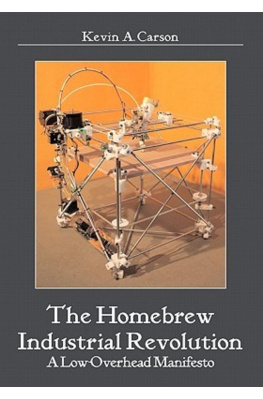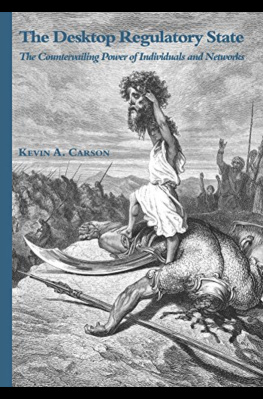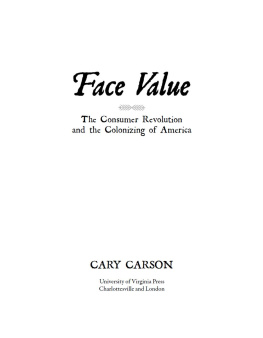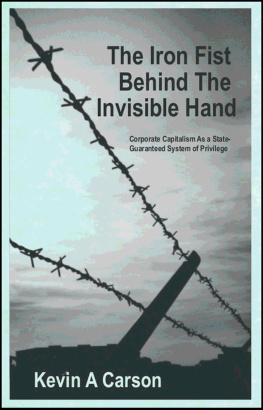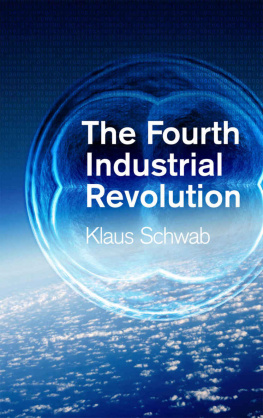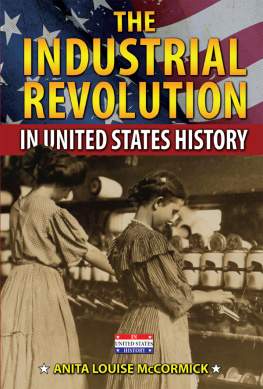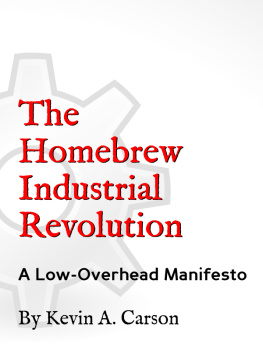Kevin Carson - The Homebrew Industrial Revolution
Here you can read online Kevin Carson - The Homebrew Industrial Revolution full text of the book (entire story) in english for free. Download pdf and epub, get meaning, cover and reviews about this ebook. year: 2010, genre: Politics. Description of the work, (preface) as well as reviews are available. Best literature library LitArk.com created for fans of good reading and offers a wide selection of genres:
Romance novel
Science fiction
Adventure
Detective
Science
History
Home and family
Prose
Art
Politics
Computer
Non-fiction
Religion
Business
Children
Humor
Choose a favorite category and find really read worthwhile books. Enjoy immersion in the world of imagination, feel the emotions of the characters or learn something new for yourself, make an fascinating discovery.
- Book:The Homebrew Industrial Revolution
- Author:
- Genre:
- Year:2010
- Rating:5 / 5
- Favourites:Add to favourites
- Your mark:
- 100
- 1
- 2
- 3
- 4
- 5
The Homebrew Industrial Revolution: summary, description and annotation
We offer to read an annotation, description, summary or preface (depends on what the author of the book "The Homebrew Industrial Revolution" wrote himself). If you haven't found the necessary information about the book — write in the comments, we will try to find it.
The Homebrew Industrial Revolution — read online for free the complete book (whole text) full work
Below is the text of the book, divided by pages. System saving the place of the last page read, allows you to conveniently read the book "The Homebrew Industrial Revolution" online for free, without having to search again every time where you left off. Put a bookmark, and you can go to the page where you finished reading at any time.
Font size:
Interval:
Bookmark:
DEDICATION:
To my mother, Ruth Emma Rickert, and the memory of my father, Amos Morgan Carson.
In researching and writing my last book, Organization Theory: A Libertarian Perspective, I was probably more engaged and enthusiastic about working on material related to micromanufacturing, the microenterprise, the informal economy, and the singularity resulting from them, than on just about any other part of the book. When the book went to press, I didnt feel that I was done writing about those things. As I completed that book, I was focused on several themes that, while they recurred throughout the book, were imperfectly tied together and developed.
In my first paper as research associate at Center for a Stateless Society, And as I wrote those papers, I began to see them as the building blocks for a stand-alone book.
One of the implicit themes in Organization Theory which I have attempted to develop since, and which is central to this book, is the central role of fixed costsinitial capital outlays and other overheadin economics. The higher the fixed costs of an enterprise, the larger the income stream required to service them. Thats as true for the household microenterprise, and for the enterprise of the household itself, as for more conventional businesses. Regulations that impose artificial capitalization and other overhead costs, the purchase of unnecessarily expensive equipment of a sort that requires large batch production to amortize, the use of stand-alone buildings, etc., increase the size of the minimum revenue stream required to stay in business, and effectively rule out part-time or intermittent self-employment. When such restrictions impose artificially high fixed costs on the means of basic subsistence (housing and feeding oneself, etc.), their effect is to make cheap and comfortable subsistence impossible, and to mandate ongoing external sources of income just to survive. As Charles Johnson has argued,
If it is true (as Kevin has argued, and as I argued in Scratching By
On the other hand, innovation in the technologies of small-scale production and of daily living reduce the workers need for a continuing income stream. It enables the microenterprise to function intermittently and to enter the market incrementally, with no overhead to be serviced when business is slow. The result is enterprises that are lean and agile, and can survive long periods of slow business, at virtually no cost; likewise, such increased efficiencies, by minimizing the ongoing income stream required for comfortable subsistence, have the same liberating effect on ordinary people that access to land on the common did for their ancestors three hundred years ago.
The more I thought about it, the more central the concept of overhead became to my analysis of the two competing economies. Along with setup time, fixed costs and overhead are central to the difference between agility and its lack. Hence the subtitle of this book: A Low Overhead Manifesto.
Agility and resilience are at the heart of the alternative economys differences with its conventional predecessor. Its superiorities are summed up by a photograph I found at Wikimedia Commons, which I considered using as a cover image; a tiny teenage Viet Cong girl leading an enormous captured American soldier. Im obliged to Jerry Brown (via Reason magazines Jesse Walker) for the metaphor: guerrillas in black pajamas, starting out with captured Japanese and French arms, with a bicycle-based supply train, kicking the living shit out of the best-trained and highest-technology military force in human history.
But Governor Brown was much more of a fiscal conservative than Governor Reagan, even if he made arguments for austerity that the Republican would never use. (At one point, to get across the idea that a lean organization could outperform a bloated bureaucracy, he offered the example of the Viet Cong.)
I since decided to go with the picture of the Rep-Rap 3-D printer which you see at the beginning of this preface now, but a guerrilla soldier is still an appropriate symbol for all the characteristics of the alternative economy Im trying to get across. As I write in the concluding chapter of the book:
Running throughout this book, as a central theme, has been the superior efficiency of the alternative economy: its lower burdens of overhead, its more intensive use of inputs, and its avoidance of idle capacity.
Two economies are fighting to the death: one of them a highly-capitalized, high-overhead, and bureaucratically ossified conventional economy, the subsidized and protected product of one and a half centurys collusion between big government and big business; the other a low capital, low-overhead, agile and resilient alternative economy, outperforming the state capitalist economy despite being hobbled and driven underground.
The alternative economy is developing within the interstices of the old one, preparing to supplant it. The Wobbly phrase building the structure of the new society within the shell of the old is one of the most fitting phrases ever conceived for summing up the concept.
Id like to thank Brad Spangler and Roderick Long for providing me the venue, at Center for a Stateless Society, where I wrote the series of essays this book is based on. I couldnt have written this without all the valuable information I gathered as a participant in the P2P Research email list and the Open Manufacturing list at Google Groups. My participation (no doubt often clueless) was entirely that of a fanboy and enthusiastic layman, since I cant write a line of code and can barely hammer a nail straight. But I thank them for allowing me to play the role of Jane Goodall. And finally, thanks to Professor Gary Chartier of LaSierra University, for his beautiful job formatting the text and designing the cover, as well as his feedback and kind promotion of this work in progress.
>.
>.
- it/>.
>.
>.
Lewis Mumford, in Technics and Civilization, divided the progress of technological development since late medieval times into three considerably overlapping periods (or phases): the eotechnic, paleotechnic, and neotechnic.
The original technological revolution of the late Middle Ages, the eotechnic, was associated with the skilled craftsmen of the free towns, and eventually incorporated the fruits of investigation by the early scientists. It began with agricultural innovations like the horse collar, horseshoe and crop rotation. It achieved great advances in the use of wood and glass, masonry, and paper (the latter including the printing press). The agricultural advances of the early second millennium were further built on by the innovations of market gardeners in the sixteenth and seventeenth centurieslike, for example, raised bed horticulture, composting and intensive soil development, and the hotbeds and greenhouses made possible by advances in cheap production of glass.
In mechanics, in particular, its greatest achievements were clockwork machinery and the intensive application of water and wind power. The first and most important prerequisite of machine production was the transmission of power and control of movement by use of meshed gears. Clockwork, Mumford argued, was the key-machine of the modern industrial age. It was
a new kind of power-machine, in which the source of power and the transmission were of such a nature as to ensure the even flow of energy throughout the works and to make possible regular production and a standardized product. In its relationship to determinable quantities of energy, to standardization, to automatic action, and finally to its own special product, accurate timing, the clock has been the foremost machine in modern technics.... The clock, moreover, served as a model for many other kinds of mechanical works, and the analysis of motion that accompanied the perfection of the clock, with the various types of gearing and transmission that were elaborated, contributed to the success of quite different kinds of machine.
Font size:
Interval:
Bookmark:
Similar books «The Homebrew Industrial Revolution»
Look at similar books to The Homebrew Industrial Revolution. We have selected literature similar in name and meaning in the hope of providing readers with more options to find new, interesting, not yet read works.
Discussion, reviews of the book The Homebrew Industrial Revolution and just readers' own opinions. Leave your comments, write what you think about the work, its meaning or the main characters. Specify what exactly you liked and what you didn't like, and why you think so.

